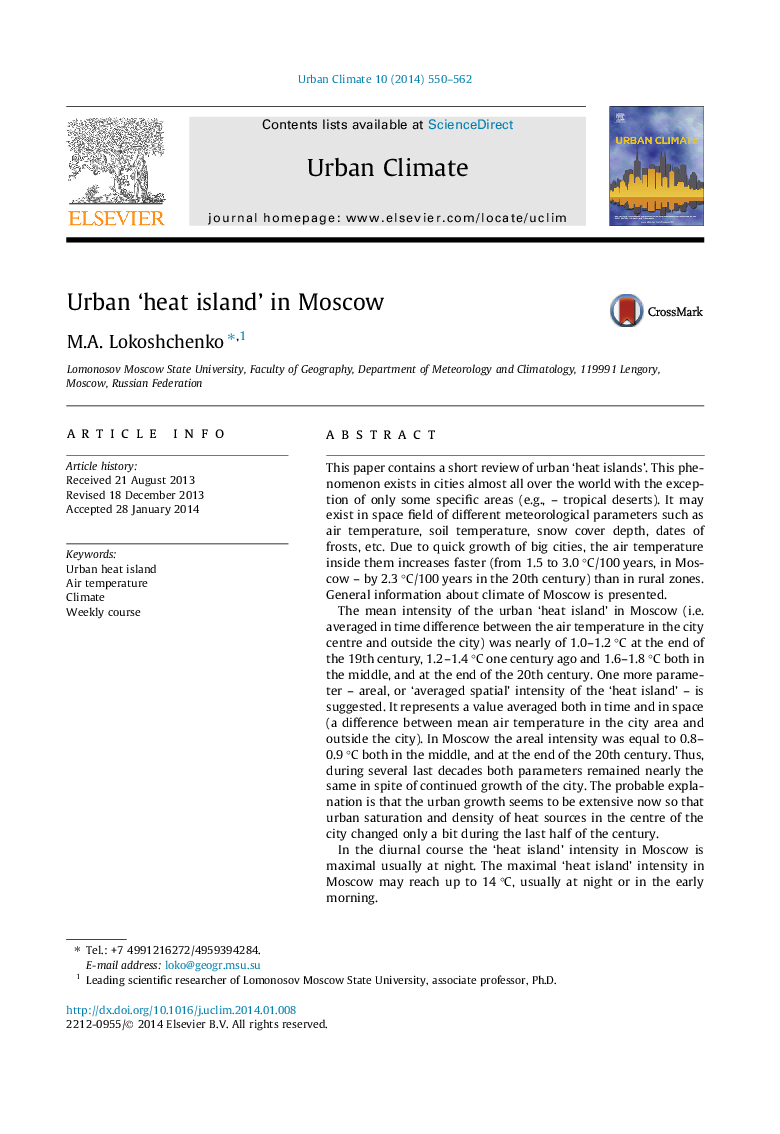| کد مقاله | کد نشریه | سال انتشار | مقاله انگلیسی | نسخه تمام متن |
|---|---|---|---|---|
| 143746 | 163470 | 2014 | 13 صفحه PDF | دانلود رایگان |
• The areal ‘heat island’ intensity is useful parameter.
• Both usual, and areal intensities in Moscow remain nearly the same during last 50 years.
• Probable explanation is extensive city growth.
• Air temperature weekly course has maximum at the end of week days and minimum after weekend.
• Probable reason is gradual accumulation of industrial haze which reduces nocturnal cooling.
This paper contains a short review of urban ‘heat islands’. This phenomenon exists in cities almost all over the world with the exception of only some specific areas (e.g., – tropical deserts). It may exist in space field of different meteorological parameters such as air temperature, soil temperature, snow cover depth, dates of frosts, etc. Due to quick growth of big cities, the air temperature inside them increases faster (from 1.5 to 3.0 °C/100 years, in Moscow – by 2.3 °C/100 years in the 20th century) than in rural zones. General information about climate of Moscow is presented.The mean intensity of the urban ‘heat island’ in Moscow (i.e. averaged in time difference between the air temperature in the city centre and outside the city) was nearly of 1.0–1.2 °C at the end of the 19th century, 1.2–1.4 °C one century ago and 1.6–1.8 °C both in the middle, and at the end of the 20th century. One more parameter – areal, or ‘averaged spatial’ intensity of the ‘heat island’ – is suggested. It represents a value averaged both in time and in space (a difference between mean air temperature in the city area and outside the city). In Moscow the areal intensity was equal to 0.8–0.9 °C both in the middle, and at the end of the 20th century. Thus, during several last decades both parameters remained nearly the same in spite of continued growth of the city. The probable explanation is that the urban growth seems to be extensive now so that urban saturation and density of heat sources in the centre of the city changed only a bit during the last half of the century.In the diurnal course the ‘heat island’ intensity in Moscow is maximal usually at night. The maximal ‘heat island’ intensity in Moscow may reach up to 14 °C, usually at night or in the early morning.Weekly course of the air temperature in Moscow is closely connected with the urban ‘heat island’ phenomenon. On the average during the last 50 years there was a gradual increase of T during week-days and sharp decrease (cooling) on weekends. This may be explained by industrial haze which is gradually accumulated from Monday to Friday and reduces effective nocturnal radiation in the city, especially during winter nights.
Journal: Urban Climate - Volume 10, Part 3, December 2014, Pages 550–562
